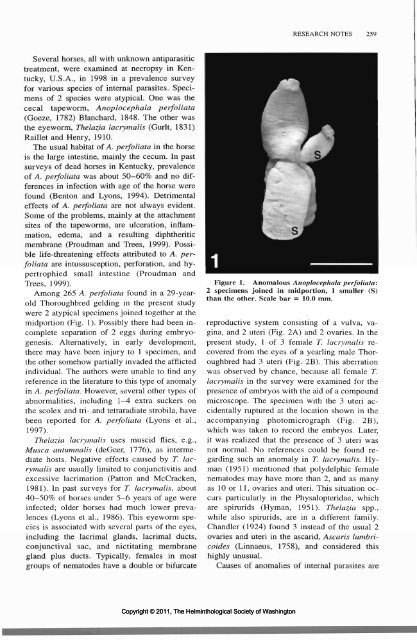Comparative Parasitology 67(2) 2000 - Peru State College
Comparative Parasitology 67(2) 2000 - Peru State College
Comparative Parasitology 67(2) 2000 - Peru State College
Create successful ePaper yourself
Turn your PDF publications into a flip-book with our unique Google optimized e-Paper software.
Several horses, all with unknown antiparasitic<br />
treatment, were examined at necropsy in Kentucky,<br />
U.S.A., in 1998 in a prevalence survey<br />
for various species of internal parasites. Specimens<br />
of 2 species were atypical. One was the<br />
cecal tapeworm, Anoplocephala perfoliata<br />
(Goeze, 1782) Blanchard, 1848. The other was<br />
the eyeworm, Thelazia lacrymalis (Gurlt, 1831)<br />
Raillet and Henry, 1910.<br />
The usual habitat of A. perfoliata in the horse<br />
is the large intestine, mainly the cecum. In past<br />
surveys of dead horses in Kentucky, prevalence<br />
of A. perfoliata was about 50-60% and no differences<br />
in infection with age of the horse were<br />
found (Benton and Lyons, 1994). Detrimental<br />
effects of A. perfoliata are not always evident.<br />
Some of the problems, mainly at the attachment<br />
sites of the tapeworms, are ulceration, inflammation,<br />
edema, and a resulting diphtheritic<br />
membrane (Proudman and Trees, 1999). Possible<br />
life-threatening effects attributed to A. perfoliata<br />
are intussusception, perforation, and hypertrophied<br />
small intestine (Proudman and<br />
Trees, 1999).<br />
Among 265 A. perfoliata found in a 29-yearold<br />
Thoroughbred gelding in the present study<br />
were 2 atypical specimens joined together at the<br />
midportion (Fig. 1). Possibly there had been incomplete<br />
separation of 2 eggs during embryogenesis.<br />
Alternatively, in early development,<br />
there may have been injury to 1 specimen, and<br />
the other somehow partially invaded the afflicted<br />
individual. The authors were unable to find any<br />
reference in the literature to this type of anomaly<br />
in A. perfoliata. However, several other types of<br />
abnormalities, including 1-4 extra suckers on<br />
the scolex and tri- and tetraradiate strobila, have<br />
been reported for A. perfoliata (Lyons et al.,<br />
1997).<br />
Thelazia lacrymalis uses muscid flies, e.g.,<br />
Musca autumnalis (deGeer, 1776), as intermediate<br />
hosts. Negative effects caused by 7". lacrymalis<br />
are usually limited to conjunctivitis and<br />
excessive lacrimation (Patton and McCracken,<br />
1981). In past surveys for T. lacrymalis, about<br />
40-50% of horses under 5-6 years of age were<br />
infected; older horses had much lower prevalences<br />
(Lyons et al., 1986). This eyeworm species<br />
is associated with several parts of the eyes,<br />
including the lacrimal glands, lacrimal ducts,<br />
conjunctival sac, and nictitating membrane<br />
gland plus ducts. Typically, females in most<br />
groups of nematodes have a double or bifurcate<br />
RESEARCH NOTES 259<br />
Figure 1. Anomalous Anoplocephala perfoliata:<br />
2 specimens joined in midportion, 1 smaller (S)<br />
than the other. Scale bar = 10.0 mm.<br />
reproductive system consisting of a vulva, vagina,<br />
and 2 uteri (Fig. 2A) and 2 ovaries. In the<br />
present study, 1 of 3 female T. lacrymalis recovered<br />
from the eyes of a yearling male Thoroughbred<br />
had 3 uteri (Fig. 2B). This aberration<br />
was observed by chance, because all female T.<br />
lacrymalis in the survey were examined for the<br />
presence of embryos with the aid of a compound<br />
microscope. The specimen with the 3 uteri accidentally<br />
ruptured at the location shown in the<br />
accompanying photomicrograph (Fig. 2B),<br />
which was taken to record the embryos. Later,<br />
it was realized that the presence of 3 uteri was<br />
not normal. No references could be found regarding<br />
such an anomaly in T. lacrymalis. Hyman<br />
(1951) mentioned that polydelphic female<br />
nematodes may have more than 2, and as many<br />
as 10 or 11, ovaries and uteri. This situation occurs<br />
particularly in the Physalopteridae, which<br />
are spirurids (Hyman, 1951). Thelazia spp.,<br />
while also spirurids, are in a different family.<br />
Chandler (1924) found 3 instead of the usual 2<br />
ovaries and uteri in the ascarid, Ascaris lumbricoides<br />
(Linnaeus, 1758), and considered this<br />
highly unusual.<br />
Causes of anomalies of internal parasites are<br />
Copyright © 2011, The Helminthological Society of Washington

















